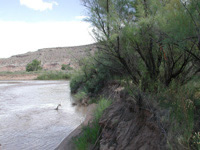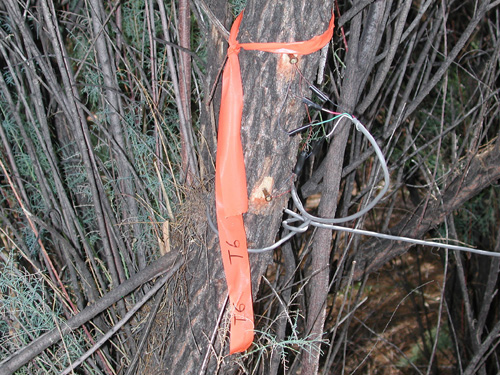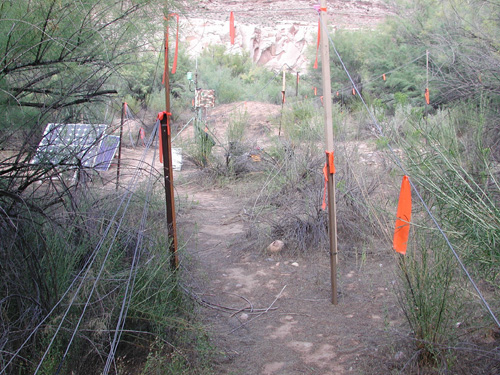Ecohydrological consequences of saltcedar beetle-induced tamarisk defoliation
The presence of tamarisk in western North America has had considerable consequences
on water resources including driving a reduction in water availability for both human
enterprise and biodiversity (Busch and Smith 1995, Stromberg 1998, Pataki et al. 2005).
Changes in streamflow via tamarisk water consumption have measurable impacts on down-stream
water appropriations and tamarisk species control has become an important aspect of
local, state and federal government efforts to manage public and private lands. Eradication
and restoration efforts are currently ongoing along many riparian corridors, but attempts
to eradicate tamarisk have had variable success. Traditional control strategies such
as mechanical removal, fire and herbicide treatments have often proven costly, unsuccessful,
or have had unintended negative ecological impacts. An alternative biological control
program was developed to control the spread of tamarisk. In 1996, the USDA - Animal
and Plant Health Inspection Service (APHIS), approved the saltcedar leaf beetle (Diorhabda
elongata Brulle) from central Asia for release (Dudley 2005). Diorhabda feeds selectively
on tamarisk in the larval and adult stages, and pupation and adult over-wintering
takes place in the litter beneath tamarisk shrubs.
In the summer of 2004, APHIS orchestrated the release of several thousand saltcedar
leaf beetles at multiple locations along the Colorado River. The goal of the beetle
release was to facilitate an aggressive long-term eradication and restoration program
in eastern Utah. The beetle has shown considerable success locally in defoliating
tamarisk and in some cases has traveled several km from the release points. However,
neither local, state nor federal agencies have coordinated a comprehensive monitoring
program to assess beetle impact on tamarisk habitat or water resources within the
Colorado Plateau region. Moreover, there are currently no data to assess whether beetle-induced
tamarisk defoliation translates into widespread mortality.
The newly established, University of Utah, Bonderman Field Station at Rio Mesa provides
an ideal opportunity to investigate the hydrologic and ecologic consequences of beetle-induced
tamarisk defoliation and mortality. As of fall of 2006, the saltcedar beetle traveled
to within 10-river km downstream of the field station before entering winter dormancy.
Current projections have the beetle moving through the field station by spring of
2008, or possibly sooner. We will exploit the local beetle release to ask the following
questions: will partial or total defoliation result in measurable long-term changes
in evapotranspiration fluxes, stream flow and groundwater discharge? Will defoliation
lead to widespread mortality? Tamarisk transpiration studies are currently ongoing
(See Figures), and we will soon begin collecting comprehensive data on streamflow
patterns, groundwater discharge and soil moisture in response to beetle-induced changes
in tamarisk activity.



Literature Cited
Busch, D.E. and Smith, S.D. (1995) "Mechanisms associated with decline of woody species in riparian ecosystems of the
southwestern U.S."Ecological Monographs 65:347-370
Dudley, T.L. (2005) "Progress and pitfalls in the biological control of saltcedar (Tamarix spp.) in North
America"Proceedings of the 16th U.S. Department of Agriculture interagency research forum
on gypsy moth and other invasive species GTR-NE-337
Pataki, D.E., Bush, S.E., Gardner, P., Solomon, D.K., and Ehleringer, J.R. (2005)
"Ecohydrology in a Colorado River riparian forest: implications for the decline of
Populus Fremontii"Ecological Applications 15:1009-1018
Stromberg, J. (1998) "Functional equivalency of saltcedar (Tamarix chinensis) and Fremont cottonwood (Populus
fremontii) along a free flowing river"Wetlands 18:675-686
